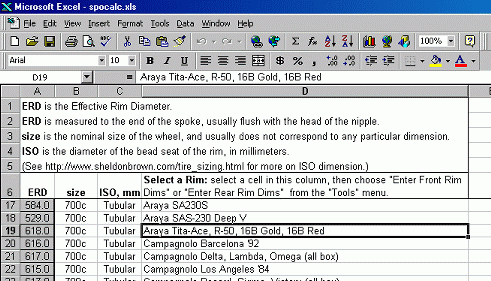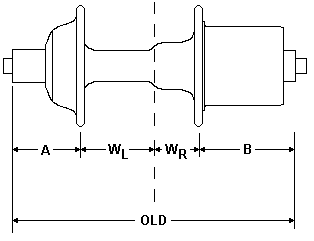Spocalc
Damon Rinard's free spoke length calculator
Disclaimer: Harris Cyclery assumes no responsibility for
the accuracy of results derived from this or any other spoke length calculator!
What is Spocalc? | Screen Shots | How to Measure Hubs and Rims | Troubleshooting | Related Sites | Other Calculators
Spocalc (full strength version)
Spocalc (174KB) |
To download, click and hold, select "Save this link as..."; Select "Source" from the Format menu.
(Windowns users, right click the link and choose "Save Target As...",) |
Spocalc is the full strength version and includes hub and rim databases. I am constantly adding new rims and hubs, so download a fresh copy frequently.
| Version Française: spocalc-fr.xls (272KO) |
Pour telecharger, cliquez et tenez, selectionnez <<Save this link as...>>; Selectionnez <<Source>> du menu <<Format.>>
(Utiliseurs de Windows, cliquez avec le touiche a droite et choisez <<Save Target As...>>) Merci a Vincent Vallet pour la traduction. |
SpocalcExpress
SpocalcExpress (16KB) |
To download, click and hold, select "Save this link as..."; Select "Source" from the Format menu.
(Windows users, right click the link and choose "Save Target As...",) |
SpocalcExpress has no hub database, no rim database, no instructions, no macros -- just the calculations that operate on the numbers you enter.
Thank Mark Schlueter for this great idea. SpocalcExpress is just like the full version of Spocalc, but less.
Enter one set of hub and rim dimensions and SpocalcExpress gives you the spoke length for radial, 1, 2, 3, 4, and any other cross of your choice. Great for Quicksheet on your Palm.
| Version Française: SpocalcExpress-fr (24KO) |
Pour telecharger, cliquez et tenez, selectionnez <<Save this link as...>>; Selectionnez <<Source>> du menu <<Format.>>
(Utiliseurs de Windows, cliquez avec le touiche a droite et choisez <<Save Target As...>>) Merci a Vincent Vallet pour la traduction. |
What is Spocalc?
Spocalc is a free Excel spreadsheet I made that calculates spoke lengths for wire spoked wheels. There are lots of other spoke calculators on the web (see the list I've assembled). Some require you to measure your own rim and hub, but Spocalc includes a database of over 350 hubs and 500 rims. The Spocalc database is also user-modifiable and -expandable so you can add more rims and hubs.
Some other spoke calculators require you to re-enter the rim and hub dimensions again and again to get different lengths for different numbers of crosses, but Spocalc automatically gives you spoke lengths for 0, 1, 2, 3, 4 and one other cross of your choosing (even a decimal number! Why would you want to do that?). Having several lengths can come in handy. Print out Spocalc's calculator sheet and take it with you when you buy spokes. If they don't have the right length for, say, three cross, you can take a glance at the sheet and decide if you could use four cross instead.
I wrote this spreadsheet using Microsoft Excel 5.0. To use it, you must have an application that can read an Excel 5.0 spreadsheet, such as Microsoft Excel 5.0 or higher, or Gnumeric (http://www.gnumeric.org).
Spocalc has a few macros to help speed data entry. When opening Spocalc, you must choose "Enable" if you wish to use these macros. If your virus checker disables them you can still use Spocalc without the macros - you just have to type in the numbers by hand.
Screen Shots
1. Main calculator sheet
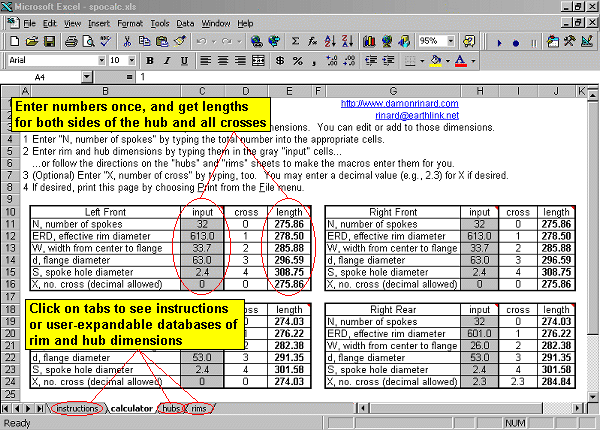
As you can see, by entering the hub and rim dimensions once, you get spoke lengths for all crosses automatically.
Although front wheels are usually symmetrical, which would make the "Left Front" and "Right Front" tables redundant, I've provided seperate left and right tables in case you are using a disc brake hub or other dished front hub.
At the bottom you can see the tabs used to view the instructions and the hub and rim database sheets.
2. Hub database sheet
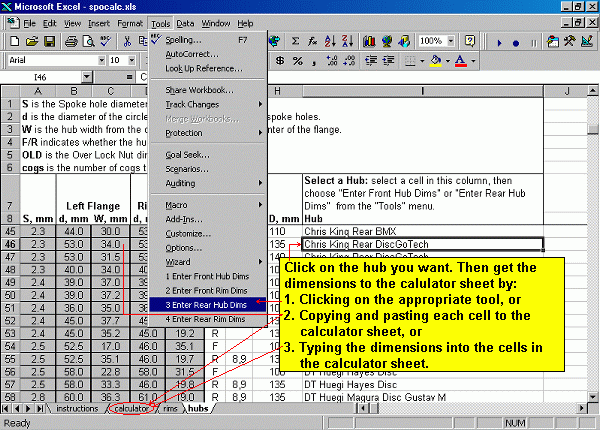
While you may certainly type in the numbers by hand, here you can see how to use the macros to enter all the hub data for you.
Important macro tip: you must first select a cell in the "Select a Hub" column before using the macro to enter the data.
3. Rim database sheet
The rims sheet works just like the hubs sheet: select the cell containing the rim you are using, then click on the appropriate Macro (from the Tools menu) to enter the Effective Rim Diameter (ERD) on the calculator page, or type the ERD number into the calculator page by hand.
How to Measure Hub and Rim Dimensions
There are five hub dimensions: dL, dR, S, WL, WR
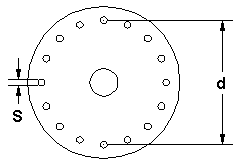 |
d, flange diameter is measured between centers of opposite holes in the hub flange. It is usually between 38 and 67 millimeters. Note that it is NOT the outside diameter of the hub's flange. Left and right flange diameters are often, but not always, the same.
S, spoke hole diameter, is the through diameter of any spoke hole. It is usually 2.6 mm. |
|
|
W, width from center to flange may differ between left and right sides of the hub. In this illustration, WL and WR are the dimensions you enter into the spreadsheet for the left and right sides of the hub, respectively. You can use a hub listed in Spocalc's database, or measure your own hub by following these steps:
Not a lot of precision is needed in the width dimensions. A few millimeters error in width will only lead to a fraction of a millimeter error in spoke length. |
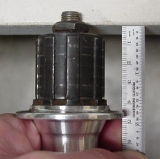 |
I usually measure A and B dimensions by holding the hub lock nut against a flat surface (like the edge of my work bench), then measuring from there back to the hub flange with a ruler or caliper.
Note that you must hold the lock nut (not the axle end) against the edge. Of course, I use two hands for better accuracy. In this photo one hand is working the camera! |
There is one rim dimension: ERD
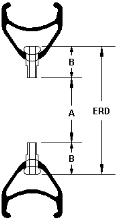 |
Effective Rim Diameter (ERD) is the diameter on which you want the ends of the spokes to lie. Most people prefer it near the end of the spoke nipple. If you want to measure your own rim (recommended, just to be sure), then follow these instructions:
Effective Rim Diameter (ERD) is the dimension you type into the spreadsheet for "ERD, effective rim diameter". Of all the dimensions you actually might measure, ERD is the most critical dimension affecting spoke length, so it makes sense to measure it a few times at different places around the rim. Always count to make sure you use spoke holes that are actually opposite each other! |
 |
Off Center or Asymmetric rims require a slight adjustment for spoke lengths. I don't know enough about Excel to make Spocalc smart enough to compensate for rim offset, but I have two work-arounds: the easy way and the exact way.
The Easy Way: Calculate spoke length as if the rim were symmetrical. Then add 1mm to the right side and subtract 1mm from the left side on rear wheels, or add 1mm to the disc side and subtract 1mm from the non-disc side of front wheels. |
The Exact Way: The idea is to adjust the hub widths to mimic the rim offset. (The change in spoke length is the same whether the rim moves relative to the hub, or the hub moves relative to the rim.) To do this, just change the left and right flange offsets by the rim offset. Here's how to do it step by step:
After entering your hub data into Spocalc,
1. Calculate your rim's spoke hole lateral offset:
- Measure the rim width (W) and divide by two. This is the rim half-width.
- Measure the distance from the near sidewall to the center of the average spoke hole (L).
- Subtract this number from the rim half-width.The result is the rim's spoke hole lateral offset (or just rim offset), i.e. the amount by which the rim reduces your wheel's dish. It is usually a couple of millimeters. Thus,
rim offset = (W/2) - L.
2. Type over the "W, width from center to flange" hub dimensions in Spocalc:
- Add the rim offset to the right flange width, and
- Subtract rim offset from the left flange width.Spocalc automatically displays the new spoke lengths.
Troubleshooting Spocalc
The spoke lengths calculated in Spocalc are based on pure 3D trigonometry: they are exact. So unless I've made a mistake in the formulas, any error must lie in the hub or rim measurements.
1. Check and double check "ERD, effective rim diameter". Errors in ERD have a direct effect on spoke length. ERD is also the easiest to get wrong, since rims are rarely round when not built into wheels, and you may measure at a large or small diameter. It is definately worth measuring ERD at several locations around the rim and averaging. The idea is to reduce the effect of any single measurement falling at a high or low spot.
2. Hub dimensions are less critical: errors here have less effect on spoke length than errors in ERD. With tangential lacing (several crosses, like three or four), flange diameter (d) is less critical than flange width (W). With radial lacing (not advisable with hub brakes or rear wheels) flange diameter becomes relatively more important.
3. Spoke hole diameter (S) is pretty inconsequential. Errors in spoke hole diameter contribute directly to errors in spoke length, but since the errors are usually so small (much less than 1 mm) they rarely make a significant difference in spoke length. Many formulas ignore spoke hole diameter entirely.
4. Also, it may seem obvious, but check to be sure you entered the correct number of spokes (N), and that you read the spoke length from the cell corresponding to the correct number of crosses. I've made both those mistakes before!
5. You can always download a current copy of Spocalc or SpocalcExpress from this page. This will fix problems like accidentally typing over hub or rim dimensions on the database sheets, or typing over formulas on the calculator sheet.
"Hey Damon, I got the macros working. In the Excel [2000] program. Go under Tools, Macros, then Security. Three option are there. I set mine on medium security. Just thought I'd let you know in case others have the same problem. Thanks for the help and the great spoke calculator." -Bob
Related Sites
Here are a few other pages on Damon Rinard's Bicycle Tech Site you might be interested in:
Hub weights
Rim weights
Spoke weights
Wheel stiffness
24 spokes in 36 hole hubs
Here are a few pages on other sites you might be interested in:
Check spoke tension by ear, by John Allen.
Robert Torre's trig derivation of the spoke length formula.
Sheldon Brown's excellent Wheelbuilding page.
Tom Ace's beautiful "3 leading, 3 trailing" pattern.
Finite-Element-Analysis of Radially Laced Bicycle Wheels.
Hed Wheels. Complete aerodynamic drag numbers tabulated.
Humphries aero wheel summary more aero drag numbers.
Rowland Cook's unusual lacing patterns.Here are manufacturer's sites you might be interested in:
American Classic - site map.
DT Swiss Bicycle Technology Menu
Mavic rims and components
Sun Rims
Tune hubs
Sapim spokes
Other Spoke Length Calculators on the Web
(These links were good when the page was put up, but unfortunately some of these webmasters have broken the links for one reason or another.)
| Calculator | Free? | Allow Decimal Cross? | Downloadable? | User-updatable Hub and Rim Database? | Lengths for many cross patterns with one data set entry? |
| Damon Rinard's Spocalc | yes | yes | yes | yes | yes |
| Seattle University Cycling Club's | yes | yes | yes | ||
| Benjamin J. Manthey | yes | yes | |||
| John Buchanan's | yes | yes | |||
| DT Swiss Spokes>calc2 | yes | yes | |||
| Pete Gray's Spokulator | yes | ||||
| Dan Halem's | yes | via e-mail | |||
| In German: http://www.tempo-sport.ch/ click on werkstatt, then Speichenl�ngen | yes |

